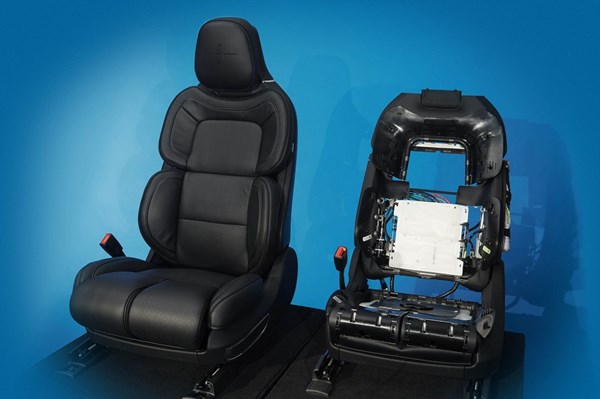SPE Auto Innovation Awards Winners Span Nine Categories
The 2016 interior category winner was also the grand award winner.
The 2016 interior category winner was also the grand award winner.
The winners of the Society of Plastics Engineers Automotive Division’s 2016 Automotive Innovation Awards spanned nine categories, including the winner of the interior category, which also garnered the “grand award”.
A panel of Blue Ribbon judges, which I again had the fortune to be on, voted for this year’s most innovative uses of plastics in automotive parts.
As in previous years, these nine winners as well as several of the other final nominees presented applications that were unique and often times represented a “first”, either as a metal replacement or as an improved plastic replacement.
It is interesting to see that this year, thermoplastics weighed-in in eight of the awards, with thermosets featured in one, with ‘composites’ popping up often.
Let’s take a look at the 2016 “grand award winner”, the second consecutive year in which the body interior category received that honor, as well as the winners of the body exterior and materials categories. I will follow up with a blog on the winners of the other six categories, and in subsequent blog posts, I’ll highlight some of the other finalists in each of those categories that I’m certain you’ll find merit attention for their innovations.
Body Interior & Grand Award Winner: Composite Suspensions for Upper and Lower Backs. Characterized as a “perfect position seat” suspension system, thanks to integrated composite designs, they are featured in Ford’s 2017 Lincoln Continental luxury sedan. This system, for which 83 patents have been filed, is said to deliver tuned suspension to optimize occupant comfort by cradling the upper back and providing side-torso support, which flexes to accommodate various occupant sizes.

Special attachment features facilitate assembly and service time. This design is also said to create a robust dynamic crash-energy management system for rear-impact protection. Molded-in color is used for Class A surfaces and craftsmanship. Moreover, this system reduced seat weight by 8% and cost by 15% despite adding more features.
Materials used include BASF’s Ultramid B3ZG7 OSI and B3EG3 nylons, Advanced Composites’ ADX 5017 TPO; and DuPont Automotive’s Delrin 100 POM. Tier I suppliers/processors were Leggett & Platt Inc. and Magna International/Summit Plastics Molding & Century Plastics.
Body Exterior: Structural Front-End Module with Active Grille Shutter. This part, featured in Ford’s 2016 Ford SuperDuty pickup, is an all-composite design without metallic reinforcement that is reportedly the first active grille shutter (AGS)-capable, injection-molded LFT-PP front-end module bolster used on a heavy-duty platform.

Replacing steel and plastic/metal hybrids at a 3 lb and $3 savings per vehicle, this design offers part consolidation with locating features that aid fit and finish, improve air flow, and meet structural requirements for part deflections of <1mm on this 8500-lb class vehicle. Shape Corp. is the Tier I supplier and Celanese’s Celstran 40-20 long-fiber thermoplastics (LFT) PP are the material.
Materials: Vacuum Brake Tubes. Featured in GM’s 2016 Chevy Silverado & Sierra pickups, this required a high-performance thermoplastic for vacuum brake tubing that could replace reinforced rubber. The OEM and Tier I supplier Cooper Standard looked for a material that had a broad temperature performance (-40 to 150 C), chemical resistance, burst strength to 60 bar minimum and flexural strength to 50 N minimum.

The material also had to resist vacuum collapse after 2 hr @ 150 C and provide retention after 336 hr @ 150 C. The design was changed to use a smaller diameter and thinner wall to simplify engine/undercarriage routing and eliminate heat shields plus allow quick connects. DSM Engineering Plastics developed Arnitel CM622, a thermoplastics polyester elastomer (TPC-ET) with high thermal oxidative stability. It is 30% lighter, less costly, and eliminates brackets.
Related Content
Expanded Line of ‘Super’ Soft TPEs for Medical Devices
Kraiburg TPE has expanded its Thermolast M series of TPE compounds by additional hardness degrees.
Read MoreMedical Grade TPEs for Biopharmaceutical Tubing
Teknor Apex expands its Medalist TPE portfolio.
Read MoreGeneral Polymers Thermoplastics to Further Expand Distribution Business
NPE2024: Following the company’s recent partnership buyout, new North American geographic territories are in its sight.
Read MoreICIS Launches: Ask ICIS Generative AI Commodities Assistant
Said to be the first of its kind, this AI assistant will enhance access to ICIS’ intelligence and insights for the energy and chemical markets.
Read MoreRead Next
People 4.0 – How to Get Buy-In from Your Staff for Industry 4.0 Systems
Implementing a production monitoring system as the foundation of a ‘smart factory’ is about integrating people with new technology as much as it is about integrating machines and computers. Here are tips from a company that has gone through the process.
Read MoreFor PLASTICS' CEO Seaholm, NPE to Shine Light on Sustainability Successes
With advocacy, communication and sustainability as three main pillars, Seaholm leads a trade association to NPE that ‘is more active today than we have ever been.’
Read MoreMaking the Circular Economy a Reality
Driven by brand owner demands and new worldwide legislation, the entire supply chain is working toward the shift to circularity, with some evidence the circular economy has already begun.
Read More














